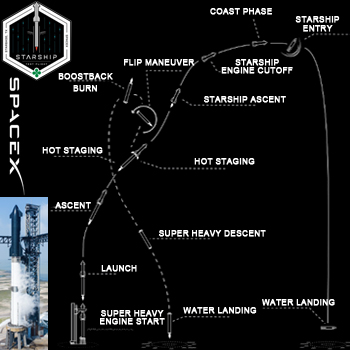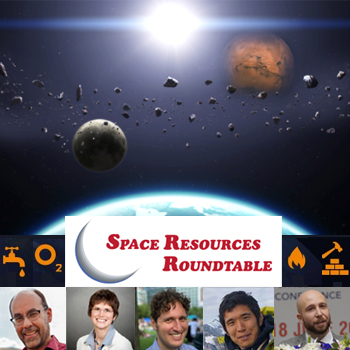Starship Test Flight 4 Set for June 5 to Last >1 Hour, Test Re-Entry Survivability
The next dramatic Starship flight launching from Starbase at Boca Chica, Texas is scheduled for NET June 5 at 07:00 CDT — and dependent on FAA approval. It will be the fourth flight of a Starship and second flight this year (Flight 3 occurred March 14). The primary objectives are to achieve a successful landing burn of Super Heavy booster and controlled entry of Starship toward proving recoverability / reusability, as opposed to the goal of achieving orbit or performing fuel transfer or other tests. The Super Heavy Boost (B11) is planned to perform a landing burn and soft splashdown in the Gulf of Mexico about 7 minutes, 4 seconds after launch. The Ship 29 upper stage will attempt a controlled entry splashdown in the Indian Ocean at 1 hour, 5 minutes, 48 seconds. Starship 33 Raptor engines cutoff is planned at 8 minutes, 23 seconds setting up the ~39-minute coast phase, followed by the entry phase where it will become transonic, then subsonic before attempting a landing flip at 1 hour, 5 minutes, 38 seconds. Among software and hardware adaptations made after Starship Flight 3, more thrusters were added to help control Starship’s attitude, and the Super Heavy hot-stage ring will be jettisoned at 3 minutes, 54 seconds to reduce booster mass. This ring will likely be replaced in the future to fit into the rapid reusability scheme. (Image Credits: SpaceX) |
MONDAY☆ Jun 3 — International Space Station, ~415-km LEO: Expedition 71 seven-member crew working with Progress 88P cargo, Astrobee – CLINGERS free flyer operation experiment, and preparing for June EVAs; planned to be nine-member crew if Starliner CST-100 crew launches June 1-2. ☆ Jun 3 — Tiangong Space Station, ~390-km LEO: Shenzhou 18 three-member crew monitoring new installations and work performed after 8.5-hour EVA in which pace debris protection devices were installed; future EVAs to install external payloads. Highlights… o NewSpace: ispace Japan in discussions with GISTDA of Thailand for potential future cislunar collaborations; Galactic Energy of Beijing successfully launches second Ceres 1 rocket from Yellow Sea platform, planning 4 sea launches this year; Pixxel of Bengaluru to launch 6 hyperspectral imagery satellites this year; Agnikul Cosmos working toward orbital flights after successfully launching 1st Agnibaan rocket. ☆ Solar System: Analyses from Magellan orbiter data (1990-1992) present evidence that Venus remains volcanically active; new study supports existence of Pluto having a subsurface water ocean with density of <1100 kg/m3; Week begins with rare alignment of 6 planets and waning crescent Moon. ☆ Galaxy: Euclid data from 24-hour observation period reveals 11 million objects in visible light and 5 million in infrared, including rogue exoplanets; existence of exoplanet HD 26965 b Vulcan called into question after NASA instrument at Kitt Peak detects inherent wobble of parent star 40 Eridani A; NASA Milky Way Lego set containing 3,091 pieces continues to inspire public since May release. o Global: South Korea establishes national space agency Korea AeroSpace Administration (KASA), plans lunar lander 2032, Mars 2045; Agreement between UNOOSA + Japan will aid Philippines and Thailand in Space Law Technical Advisory Missions; CNSA Chang’E-6 is set to land and return samples from far side this week while JAXA to continue sending communications to SLIM lander in hopes for 4th awakening later this month. ● USA: India and USA working towards flight of India Vyomanaut to ISS as early as 2024; NASA-led Artemis Accords accelerating with Slovakia becoming signatory #42; Perseverance Mars Rover sample return solicitation yields 48 proposals for NASA future appraisal. ● Hawai’i: ‘Imiloa Astronomy Center featuring new program on submillimeter observatories on Mauna Kea; Women’s STARS 5-day Program accepting applications through end of week; 4-person student team ‘Lunar Vulcans’ at UH Hilo researching ‘uala (sweet potato) growth for NASA Moon food security competition. |
 |
● = Terrestrial and… o = International terrestrial events
☾ = Moon activity ★ = Space and… ☆ = International space / astro events in Hawaii Standard Time unless noted. Add 10 hours to obtain UT (‘Universal Time’). |
Weekly Planet Watch – Morning Planets: Mars (ESE), Saturn (ESE).
CO School of Mines Assembles the 24th Space Resources Roundtable
Space Resources Roundtable will be convened by SRR President Dr Angel Abbud-Madrid at Colorado School of Mines, Golden, June 6-9, for world experts to address space-resource activities in cislunar space and on the Moon, Mars and small bodies, with presenters from Australia, Japan, Luxembourg, Canada, Germany, Turkey, United Kingdom, Hong Kong, South Korea and USA. Space agencies, research organizations, mining companies, manufacturers for transport, infrastructure and robotics, and analysts of legal, policy, economic, ethics and environmental issues will present technical papers and posters and engage in roundtable discussions. The Keynote Presentation is by Morgan Hendry of Blue Origin on “Space Resources for the Benefit of Earth.” NASA updates include Gerald Sanders on In-Situ Resource Utilization (ISRU), Julie Kleinhenz on PRIME-1 and VIPER, which is planned for mission to the Moon South Pole to view concentration of water, ice. Other NASA updates to include testing results of TRIDENT Drill, ice formation experiments, effect of vacuum on Ultrasonic Penetrator, Regolith Simulant, Lunabotics Competition on Site Preparation, the International Mars Ice Mapper Mission, and Comparing Hydroponics and Regolith Growth and Evolution (CHRGE). Jun Shimada will report on JAXA’s Study of a Lunar ISRU Pilot Plant, Antonino Salmeri on Space Law, Laszlo Keszthelyi of USGS on Lunar Resource Assessments, and Thomas Gardner and Jeffrey Parker of Advanced Space on cislunar navigation. (Image Credits: CO School of Mines, SRR, PTMSS, NASA, SpaceResources.lu) |
● Jun 3-7 — Colorado School of Mines, Golden CO: 24th Meeting: Space Resources Roundtable (SRR 2024). ☆ Jun 3 — Mercury: 5.0° SE of the Pleiades, 08:00; with Jupiter and Pleiades within circle of diameter 5.09°, 10:00. Ongoing… ● May 28 – Aug 7 — LPI-JSC Center for Lunar Science and Exploration, Houston TX: Exploration Science Summer Intern Program. ★ NET Jun / Summer — SpaceX, Launch Falcon 9 / Polaris Dawn Crew Dragon, LC-39A, Kennedy Space Center FL: Jared Isaacman, Scott Poteet, Sarah Gillis, and Anna Menon to reach apogee of 1,400 km, perform first commercial EVA, and test spacecraft-to-spacecraft communications with Starlink on 5-day mission. o NET Jun — Australia Space Agency, Adelaide, Australia: Two national industry consortia AROSE and EPE & Lunar Outpost Oceania rover prototypes to be developed by this month. TUESDAY☾ Jun 4 — Chang’E-6 Lunar Sample Return, Apollo Basin, South Pole–Aitken Basin: Up to 2kg of samples from lunar regolith taken from scooping / drilling on lunar farside from a depth of up to 2 meters now in return capsule to be returned to Inner Mongolia, China. ● Jun 4 — The Washington Post, Washington DC: The New Space Age with the Artemis II Crew; a discussion with NASA Astronauts Reid Wiseman, Victor Glover and Christina Koch and Canadian Space Agency Astronaut Jeremy Hansen. ☾ Jun 4 — Moon: At superior conjunction with Sun, 1.735 AU from Earth, 05:00; with Jupiter and Pleiades within circle of diameter 5.21°, 23:00. ☆ Jun 4 — Mercury: 0.12° SE of Jupiter, 01:00. ☆ Jun 4 — Venus: At superior conjunction with Sun, 1.735 AU from Earth, 05:00 ☆ Jun 4 — Apollo Asteroid 2024 KF: Near-Earth Flyby (0.063 AU) |
WEDNESDAY
★ NET Jun 5 — SpaceX, Launch Starship (4th Flight), Starbase, Boca Chica TX: Starship Flight Test 4 with Super Heavy Booster 11 (splashdown in Gulf of Mexico) and Ship 29 upper stage (powered descent in Indian Ocean after 1 hour, 5 min, 48 sec mission).
☆ Jun 5 — Tiangong Space Station, ~390-km LEO: Today marks 2nd full year / starts 3rd year of continuous Human occupation of TSS; Shenzhou 14 three-member crew launched on this day in 2022, beginning occupation.
● Jun 5-7 — National Academies of Sciences, Engineering and Medicine Space Studies Board (SSB), Washington DC: 2024 Spring Meetings of SSB.
☾ Jun 5 — Moon: 0.41° SE of Pleiades, 00:00; 4.5° N of Jupiter, 03:00; with Mercury and Jupiter within circle of diameter 4.77°, 04:00; 4.5° N of Mercury, 07:00.
☆ Jun 5 — Venus: At brightest, magnitude -3.91°, 00:00.
☆ Jun 5 — Apollo Asteroid 2008 YN2: Near-Earth Flyby (0.026 AU)
THURSDAY
● Jun 6-7 — NSF-NASA-DOE Astronomy and Astrophysics Advisory Committee (AAAC), Alexandria VA and Online: Meeting of the AAAC.
☾ Jun 6 — Moon: New Moon, 02:39; 4.5° N of Venus, 04:00.
☆ Jun 6 — Mars: Winter solstice for Mars northern hemisphere, 19:00.
☆ Jun 6 — Aten Asteroid 2021 LW3: Near-Earth Flyby (0.024 AU)
FRIDAY
☆ Jun 7 — Daytime Arietid Meteors: Meteor shower offers up to 30 per hour, they streaming from a radiant point in constellation Aries.
☾ Jun 7 — Moon: 4.1° N of M35 cluster, 07:00.
☆ Jun 7 — Mercury: 5.3° NNW of Aldebaran, 16:00.
☆ Jun 7 — Aten Asteroid 2024 BD4: Near-Earth Flyby (0.063 AU)
SATURDAY
● Jun 8-13 — Space Northwest, New Space Nexus, The Museum of Flight, USSF, Air Force Research Lab, et al, Seattle WA: Seattle Space Week 2024; 6 different venues
● Jun 8 – Aug 3 — International Space University (ISU), Rice University, NASA, Johnson Space Center, Houston TX: 36th ISU Space Studies Program (SSP 2024).
☾ Jun 8 — Moon: 5.1° S of Castor, 17:00; 1.74° S of Pollux, 22:00.
SUNDAY
● Jun 9 — Pacific International Space Center for Exploration Systems (PISCES), University of Hawai’i at Hilo, Maunakea Observatories, Online / Hawai’i Island: Applications Due: Women’s STARS (STEM Aerospace Research Scholars) Program 2024; being held Jul 15-19.
● Jun 9-13 — American Astronomical Society, Madison WI: 244th Meeting of the AAS; at Monona Terrace Convention Center.

